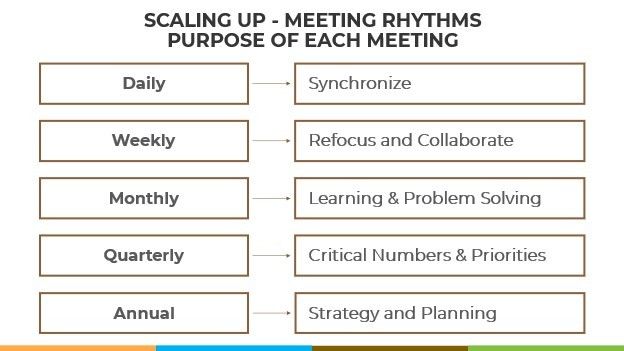In the dynamic world of fast-growing businesses, the rhythm of meetings is pivotal. Establishing a structured cadence ensures alignment, fosters accountability, and accelerates decision-making. As a seasoned CEO scaling up practitioner and certified Scaling Up coach, I have witnessed the transformative power of well-executed meeting rhythms. Let’s delve into the critical components of effective meeting rhythms and their profound impact on organizational growth.
Daily Huddles: Synchronize and Mobilize
Purpose and Structure:
Daily huddles are brief, standing meetings lasting 7-15 minutes. They are essential for daily synchronization and provide a pulse-check on immediate issues. Their primary purpose is to evaluate progress on short-term priorities and identify obstacles that need immediate attention.
Key Components:
- What’s Up: Share relevant news or updates.
- Quarterly Individual Priority KPIs: Track each team member’s progress on key performance indicators.
- Stucks: Discuss any issues preventing forward movement.
- Top Priority: Each team member commits to their most crucial task for the day.
By maintaining this rhythm, companies can take immediate corrective actions on priorities and KPIs, fostering a culture of accountability and continuous improvement.
4D Weekly Huddle: Discover, Discuss, Decide, Delegate
Purpose and Structure:
Weekly huddles vary in duration—30 minutes for front-line teams and 60-90 minutes for executives. These meetings focus on collaboration, status updates, and deeper dives into significant issues.
Sample Agenda:
- Good News (5 minutes): Share both professional and personal successes to foster a positive start and build human connections.
- Customer/Employee Data (10 minutes): Review feedback and performance metrics.
- Quarterly Priorities (10 minutes): Assess progress on key objectives.
- Collective Intelligence (30 minutes): Discuss 1-2 key topics based on trends, feedback, and priorities.
- Who, What, When (5 minutes): Summarize next steps and assign responsibilities.
The 4D Weekly Huddle ensures that the team leverages collective intelligence to solve problems and make informed decisions. It also provides an opportunity for group coaching and recognition of exceptional efforts.
Monthly Meetings: Learn and Solve
Purpose and Structure:
Monthly meetings, lasting 2-4 hours, gather senior, middle, and frontline managers to address significant issues collaboratively. These sessions are held soon after financials are available to ensure timely decision-making.
Sample Agenda:
- Who, What, When: Review previous meeting actions.
- Dashboards Review: Assess progress and necessary adjustments.
- Annual Priorities: Evaluate and discuss.
- Brainstorming: Explore strategic opportunities like new services or partnerships.
- Learning Opportunity: Provide education on relevant topics.
- Summary and One-phrase Close: Conclude with clear next steps.
Monthly meetings are crucial for evaluating quarterly priorities and making decisions on corrective actions. They also provide a platform for transferring leadership knowledge and fostering a learning culture.
Quarterly and Annual Meetings: Setting the Course
Quarterly Meetings:
These half to full-day sessions are dedicated to reviewing and resetting priorities and goals for the next 13-week cycle. They provide an opportunity to reflect on the past quarter, assess what worked, and strategize for the upcoming period.
Annual Meetings:
Annual meetings span two days and involve a comprehensive assessment of the previous year’s plan. They are critical for testing current realities and formulating new strategies. This thorough evaluation and planning process ensures the organization stays on course toward its long-term objectives.
Implementing Effective Meeting Rhythms
To successfully implement these meeting rhythms, follow these key principles:
- Commitment to Timeframes: Ensure meetings do not exceed their allotted time.
- Consistency: Hold meetings at the same time and place each week or month to establish a routine.
- Engagement: Encourage active participation and accountability from all team members.
- Feedback: Conclude meetings with a quick feedback session where participants rate the meeting and suggest improvements.
Conclusion
Mastering meeting rhythms is essential for scaling up success. By establishing a structured cadence of daily, weekly, monthly, quarterly, and annual meetings, organizations can ensure alignment, foster accountability, and accelerate decision-making. These rhythms create a framework for continuous improvement and strategic growth, enabling companies to achieve their ambitious goals while maintaining a cohesive and motivated team.
As you implement these meeting rhythms, remember to tailor them to your organization’s culture and needs. The key is consistency and commitment, ensuring that each meeting serves its purpose in driving the organization forward. Embrace the power of meeting rhythms and watch your organization scale new heights of success.
By integrating these meeting rhythms into your organizational practices, you set the stage for sustained growth and performance. Whether you are a seasoned executive or a budding entrepreneur, mastering the art of effective meetings will be a game-changer in your scaling-up journey.
If you would like a copy of the Aspire Meeting Rhythms Summary for use with your team, please email herb@aspiregrowthadvisors.com. This comprehensive guide will help you implement these proven strategies and enhance your meeting efficiency, driving your organization towards greater success.

